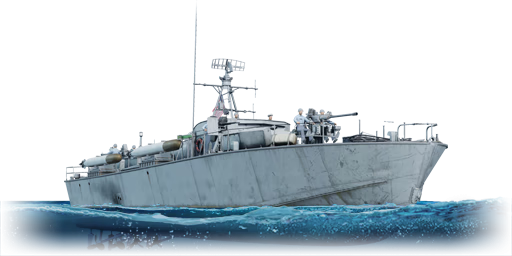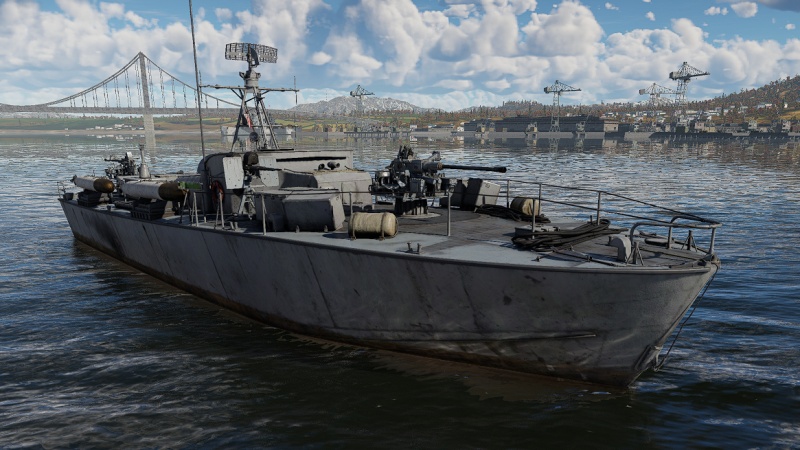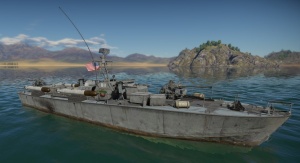PT-811
Contents
Description
The 94 ft PT-811 is a premium gift rank IV American motor torpedo boat with a battle rating of 3.7 (AB/RB/SB). It was introduced during Update 1.95 "Northern Wind" in the Operation F.R.O.S.T. event as the first naval reward ship for acquiring 5 of the 12 available "Mark of Distinction"s.
General info
Survivability and armour
PT-811 is a step-up over her tech tree cousins, as she isn't made of wood and her hull instead is made of 10 mm of steel. This allows her to absorb rifle and machine gun calibre projectiles somewhat well, which is helpful when a plane with weaker guns goes for a strafe run, but against most of your waterborne opponents (who, on average, will be totting multiple autocannons or even larger weapons), you're not likely to take much more than a few salvoes to be sent to the bottom, especially if one is unfortunate to come across some early destroyers, whose large calibre artillery will hullbreak you with a single good hit. Her somewhat large crew for a PT boat will make sure that near misses or weaker attacks won't send you back to the hangar as quickly as other PT boats, but overall her survivability lies not within her hull, but her mobility.
Mobility
This is where PT-811 comes into a league of her own. Four 2,500 hp Packard W-100 gasoline engines powering four shafts combined with a new design of hull leads to PT-811 being one of the fastest vessels in War Thunder to date! Clocking in at a rapid 88 km/h (54 mph) in Realistic Battles, and a whopping 124 km/h (77 mph) in Arcade Battles makes you an incredibly fast boat. This allows you to not only capture objectives far faster than many other players, but allows you to enact lightning fast attacks against larger vessels, as your massive speed gives you the advantage you need to get close, launch those torpedoes, and get to scramble for cover before they even know what hit them! PT-811 isn't perfect in the mobility department however, as coming to a full stop or reversing is quite a chore, as her low-drag hull makes it difficult to slow down, and her rudder shift isn't quite as sharp as some other PTs, so make sure to plan your next move carefully, otherwise you might find yourself overshooting your cover, and finding yourself in open water or ran aground and in full sight of the enemy.
| Mobility Characteristics | |||
|---|---|---|---|
| Game Mode | Upgrade Status | Maximum Speed (km/h) | |
| Forward | Reverse | ||
| AB | |||
| Upgraded | 124 | 46 | |
| RB/SB | |||
| Upgraded | 88 | 33 | |
Modifications and economy
Armament
Primary armament
To those of you who have already played quite a few of the later American PT boats, you will be very familiar with the legendary Bofors already, and how good it is at tearing apart softer targets such as other PT boats, or overconfident aircraft. With a somewhat fast fire rate, good shell velocity and very punchy ammo, it will only take a few good hits to bring down any aircraft getting close, and will more than happily destroy any other PT boat you might find on your travels from point to point. They're also quite good at taking out key modules on larger vessels, such as a main turret that's slewing towards you, or a stack of depth charges on the rear of an enemy destroyer. Anything bigger, though, and they will begin to struggle. Don't expect them to be able to gun down a destroyer! Punching lots of small holes on the waterline might seem like a good tactic at first, but it will take a while for them to go under, leaving you very vulnerable to counterfire, which won't end well for you.
- Universal: AP-T · HEFI-T
- 40 mm AP clips: AP-T · AP-T · AP-T · HEFI-T
- 40 mm HE clips: HEFI-T · HEFI-T · HEFI-T · AP-T
| Penetration statistics | |||||||
|---|---|---|---|---|---|---|---|
| Ammunition | Penetration @ 0° Angle of Attack (mm) | ||||||
| 10 m | 100 m | 500 m | 1,000 m | 1,500 m | 2,000 m | ||
| HEFI-T | 3 | 3 | 3 | 3 | 3 | 3 | |
| AP-T | 81 | 78 | 68 | 58 | 49 | 41 | |
| Shell details | ||||||||||||
|---|---|---|---|---|---|---|---|---|---|---|---|---|
| Ammunition | Velocity (m/s) |
Projectile mass (kg) |
Fuse delay (m) |
Fuse sensitivity (mm) |
Explosive mass (TNT equivalent) (g) |
Ricochet | ||||||
| 0% | 50% | 100% | ||||||||||
| HEFI-T | 874 | 0.9 | 0 | 0.1 | 67.13 | 79° | 80° | 81° | ||||
| AP-T | 874 | 0.89 | - | - | - | 47° | 60° | 65° | ||||
Secondary armament
Another weapon most American PT captains will be very used to at this point. With a fast fire rate, quick reload, and quite hard-hitting shells, the Oerlikon 20 mm cannons are the butter to the Bofors bread. Whilst they aren't quite as lethal as one might be used to, due to the fact that PT-811 will be fighting thicker skinned targets than what lower battle rating PT boats are used to. They make for great backup anti-air guns for when you're busy fighting surface targets. Don't rely on them totally, though, as a more experienced pilot will know how to better avoid their fire, or will attempt to use cover to get within striking range before the Oerlikons have a chance to light them up.
- Universal: HEF-T · HEF-I · AP-T
- 20 mm HE: HEF-T · HEF-I · AP-T · HEF-I
- 20 mm AP: AP-T · AP-T · AP-T · HEF-I
| Penetration statistics | |||||||
|---|---|---|---|---|---|---|---|
| Ammunition | Penetration @ 0° Angle of Attack (mm) | ||||||
| 10 m | 100 m | 500 m | 1,000 m | 1,500 m | 2,000 m | ||
| HEF-T | 2 | 2 | 2 | 2 | 2 | 2 | |
| AP-T | 34 | 32 | 24 | 17 | 12 | 8 | |
| HEF-I | 2 | 2 | 2 | 2 | 2 | 2 | |
| Shell details | ||||||||||||
|---|---|---|---|---|---|---|---|---|---|---|---|---|
| Ammunition | Velocity (m/s) |
Projectile mass (kg) |
Fuse delay (m) |
Fuse sensitivity (mm) |
Explosive mass (TNT equivalent) (g) |
Ricochet | ||||||
| 0% | 50% | 100% | ||||||||||
| HEF-T | 830 | 0.12 | 0 | 0.1 | 6.57 | 79° | 80° | 81° | ||||
| AP-T | 830 | 0.12 | - | - | - | 47° | 60° | 65° | ||||
| HEF-I | 830 | 0.12 | 0 | 0.1 | 11.17 | 79° | 80° | 81° | ||||
Anti-aircraft armament
Sadly the 81 mm mortar is not the best weapon for anti-ship or anti-aircraft warfare, as its slow fire rate, poor ballistic arc, slow shell travel speed and somewhat lacklustre bursting charge render this weapon mostly useless, but can find very limited use when a particular soft target is hiding behind cover and isn't moving. One can use the high ballistic arc to shoot over solid cover to strike a hiding opponent, forcing them to come out and fight or to risk being hit by a mortar shell.
Additional armament
Recently, PT-811 had its torpedoes changed from the 569 mm Mark 13 torpedoes to the far more potent 533 mm Mark 16 torpedoes. These newer torpedoes travel fast, at 85 km/h, and have a rather long travel distance of 6.40 km. The real kicker of these torpedoes is their bursting charge, however, as they have 572 kg of torpex as their warhead, which is equal to a massive 915.2 kg worth of TNT! This ensures that any vessel that's unlucky enough to be hit by even one of these torpedoes is crippled, if not sunk outright, by such a heavy hit. This makes PT-811 a very ferocious threat to the large ships of War Thunder, as these powerful torpedoes combined with her very fast hull makes for a small and fast mosquito with a lion's bite. To cap it all off, the PT-811 has access to four of these potent torpedoes.
Usage in battles
PT-811 is the embodiment of the PT idea. A very small and fast vessel equipped with large ship-destroying torpedoes that is capable of striking fast, dealing a lot of damage, and then getting out of trouble as fast as it got into it whilst having enough guns to protect itself from planes and other small vessels. It's the apex of its kind, and should be played as such. Use that massive speed advantage to take capture zones or key ambush positions very early into a match, catch large enemy vessels by surprise, launch your attack and then retreat just as fast before your target or his allies have a chance to retaliate.
Whilst you have good guns, attacking other small ships is probably better left to your allies in better equipped vessels, as your thin hull and small crew won't last long under concentrated fire. A few opponents to be very wary of are "PT-Killer" boats, such as the PG-02, Pr.206 or Jaguar-Klasse (140), as these boats have enough speed to keep up with you long enough for their powerful armament to send you to the bottom. If the worst happens, and you find yourself against one of these opponents or something similar, try to shoot out their main guns and run whilst they're repairing. This also works well against frigate-like vessels such as the Pr.159 and River-class.
A final key opponent to keep an eye out for is low flying attacker aircraft armed with big calibre guns or rockets, such as the IL-2 or the Beaufighter. These planes are tough enough to take a good few 20 mm hits and rip you up with their powerful guns, so keep an ear out for that tell-tale whirr of propellers and be ready to switch to your 20 mm cannons, or better yet, guess where they're coming from and have your Bofors ready to greet them.
Pros and cons
Pros:
- Incredibly fast!
- Effective and powerful torpedoes
- Solid weaponry for a ship of this type
Cons:
- Hullbreaks easily from any high-calibre direct hit
- Poor deceleration and mediocre rudder shift
- Regularly faces very powerful boats that outgun it
History
PT-811 was laid down on the 17th of March 1949 by John Trumpy and Sons in Annapolis, MD. She was then launched on the 30th of November 1950 and subsequently completed on the 6th of March 1951. She was part of a program to use lessons learned in World War Two to create a new generation of PT boats, and to evaluate their worth. Despite stellar performance in comparison to the vessels used in World War Two, there simply wasn't much of a need for PT boats in the modern war, and so she was struck from the Naval Register on the 1st of November 1959. For a brief stint she was brought back from her mothballed state to be reinstated onto the Naval Register and was reclassified as Fast Patrol Craft, PTF-2 on the 21st of December 1962. Sadly, her new chance at life was soon over as she was sunk as a target sometime in August 1965 off of the Hawaiian Islands, where she assumedly lays to this day.
Media
- Skins
- Images
- Videos
See also
- 89 ft PT-810 - Tech-tree equivalent of 811, that shares a similar history and playstyle
- Brave class (P1011) - British tech-tree equivalent that shares a similar playstyle
External links
| John Trumpy and Sons | |
|---|---|
| Patrol Torpedo Boats | |
| Experimental 94’ PT | PT-811 |
| USA boats | |
|---|---|
| Motor torpedo boats | PT-3 · PT-6 · PT-20 · PT-71 · PT-103 · PT-109 · PT-174 |
| PT-200 · PT-314 · Thunderbolt (PT-556) · PT-565 · PT-658 · PT-810 · PT-811 · PT-812 | |
| Motor gun boats | Kim Qui · LCS(L)(3) · PT-59 · PTF-7 · USS Candid · USS Asheville · USS Douglas · USS Flagstaff · USS Tucumcari · USS Cyclone |
| Armoured gun boats | LCM(6) Zippo |
| USA premium ships | |
|---|---|
| Motor torpedo boats | PT-3 · PT-109 · PT-174 · Thunderbolt (PT-556) · PT-658 · PT-811 |
| Motor gun boats | LCM(6) Zippo · USS Douglas · USS Flagstaff |
| Sub-chasers | Carmi (PC-466) |
| Destroyers | USS Welborn C. Wood · USS Wilkinson · USS Bennion · USS Cowell · USS Davis · USS Moffett · USS Phelps · USS Frank Knox |
| Light cruisers | USS Detroit · USS Helena |
| Heavy cruisers | USS Des Moines |
| Battleships | USS Arkansas |






